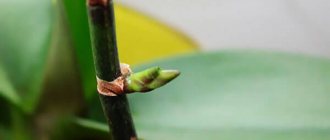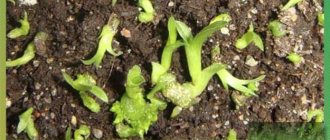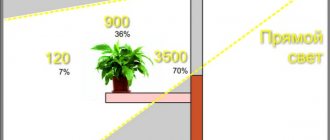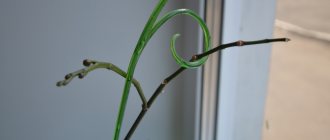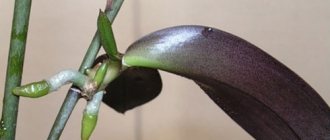Propagation of orchids by peduncles is the easiest way to obtain a new plant. After prolonged flowering, the orchid flowers dry out and fall off, then small plants - babies - often develop on the flower stalk. They are quite easily separated from the mother orchid and take root. This method can be considered the easiest to obtain a new plant. Next, you will learn how to grow an orchid from a peduncle.
Caring for a plant to produce babies
The baby (shoot) of an orchid is a fully formed, miniature plant with leaves, stem and roots.
Phalaenopsis orchid babies.
In order for children to form on the peduncle, after the end of the flowering period, the arrow must be shortened to a height of 1.5-2 cm above the upper dormant bud. As a rule, children develop on their own; for this it is only necessary to create optimal conditions for the plant:
- a large amount of bright diffused light;
- quite high daytime temperature – about +27-30℃. If you want a flower shoot to form from dormant buds, the room temperature should be no more than 24℃;
- Poor watering of the plant is combined with high humidity (60-80%). To do this, the orchid is regularly sprayed and placed on a tray with wet sand or moss.
Having created the necessary conditions, it is quite easy to awaken dormant buds and cause the appearance of children.
Additional Tips
To ensure minimal evaporation and proper flow of water into the fabrics, store the bouquet in a dark, cool room with a high level of humidity (at least at night). You can place them in a bucket of water and cover with gauze. Do not place the composition on the windowsill, where they are exposed to the rays of the sun, drafts, or heat from radiators.
Do not touch the petals and pistil with your hands - the latter contains pollen, which is responsible for the life of the flower.
Surprisingly, cut orchids cannot be irrigated - moisture ingress contributes to the appearance of a brownish coating on the petals. Don’t be afraid to use chemical additives (Cornell, Bud, Etisso) - they can extend the life of the plant. The main thing is that they are specially designed for orchids.
What folk methods really work?
- Activated carbon destroys toxins from water.
- Aspirin and boric acid promote disinfection and accelerate the process of its absorption by plant cells.
- Vodka stops the growth of bacteria in bouquet flowers
. - Sugar in combination with pine concentrate provides nutrition to the plants.
In winter, flowers for bouquets are additionally insulated during transportation so that they do not become overcooled.
Timing for vegetative propagation
After the end of the flowering phase, the best period for the development of children begins. In this case, the following requirements are imposed on an adult plant:
- the orchid must have a developed root system and at least 2 pairs of large leaves;
- it must be in the final flowering phase;
- The best time of year is spring or early summer.
In low humidity or low light conditions, which is typical for the autumn-winter period at home, babies do not form on the peduncle.
Using a peduncle to propagate “phalaenopsis”
Phalaenopsis orchids are often used for propagation using a peduncle. The following are used:
- Children with roots. They appear as lateral shoots on the peduncle. They grow quickly with proper care, and the replanting process is very simple.
- Cuttings. The peduncle removed from the plant is cut into pieces, which are placed for rooting.
The highest quality flower stalks of “phalaenopsis” appear in late autumn. And after flowering, no later than three months, they can be used for propagation. At a later date after the end of flowering, the planting material is not used.
Stimulation: use of cytokinin paste
A paste based on the phytohormone cytokinin is a preparation that is widely used in floriculture. It actively influences plant cell division, awakening dormant buds, and stimulates growth and flowering.
Its application is as follows:
- on a faded peduncle, choose a dormant bud, the uppermost or lower one, as they give a more predictable result;
- with a sharp object (knife, scalpel, needle), cut the dense scales on the kidney;
- Using tweezers, remove the cut off parts of the scale. A small bright green dot will open under them - a bud with which we will work;
- Apply a little paste onto it with a cotton swab (a ball about 2 mm in diameter). For better penetration of the drug, the kidney can first be slightly scratched with a needle. All manipulations are carried out very accurately;
- The surface of the kidney is completely and evenly lubricated with the paste.
Stimulation of a dormant kidney with cytokinin paste.
Attention! It is not recommended to treat more than two dormant buds on a peduncle with cytokinin.
7-10 days after applying the paste, you can expect the first signs of a growing baby or flowering shoot to appear.
Step-by-step instructions for growing at home
In addition to growing babies on a peduncle, there are several other methods, and we will describe each of them in detail.
How are they formed naturally?
After the orchid finishes blooming, in order to grow a baby on the peduncle, it is necessary to recreate special natural conditions for the plant and create a little peculiar stress.
- The best time of year for growing babies on a peduncle is spring. Stimulation of the kidneys can begin as early as February, when daylight hours begin to gradually increase to 10 hours.
- By the beginning of spring, move the pot to a window on the west side. Thus, the plant will be exposed to sunlight for about 5-6 hours a day.
- It is also necessary to ensure sudden temperature changes. During the daytime, the temperature should remain at a level of +25 to +27 degrees, and at night drop to +15-17 degrees.
- Watering should be no more than once every 7-10 days.
- Until the bud wakes up, you should not fertilize or feed the orchid.
Can the culture produce keiki after stimulation?
If for some reason the orchid does not reproduce on its own, this process can be stimulated with a special means. Cytokinin paste has proven itself best in this matter.
The process of stimulation with cytokinin paste is as follows:
- First of all, you need to warm the paste to room temperature.
- Decide on the peduncle on which you want to raise the baby and choose the healthiest bud available.
- Disinfect the knife and use its tip to carefully separate the scaly skin on the kidney.
- Moisten the exposed area with water, and then, using a thin needle, evenly apply a small amount of cytokinin paste.
- The result should appear within two months.
You cannot process more than 3 buds on one orchid. If several babies appear at once, you need to choose the strongest one and remove the rest.
How to grow in water on a peduncle cutting?
This method is suitable for growing babies on sick, young or weakened plants. In this state, the orchid is simply not able to form a baby on its own, but this does not mean that you cannot stimulate this process. To do this you need:
- Separate the peduncle from the plant and cut it into separate parts so that each has a while.
- Fragments of the peduncle must be placed in water with activated carbon. The water level should be a few cm above the cut. It is necessary to change the water every 3-4 days.
- As soon as the babies form on the fragments of the peduncle, you need to start spraying them with nitrogen fertilizers. This must be done once a week.
How to get it from a part of a plant?
Another way to grow babies is to divide the mother plant into parts. The division occurs as follows:
- The plant must be removed from the pot and properly shaken off the substrate.
- Then the root system must be soaked for half an hour in warm water.
- Next, the bush must be carefully laid out on a newspaper and, with a sharp, disinfected knife, cut off the upper part of the plant, capturing several aerial roots. Please note that the cut part must have at least 5 leaves.
- All cut areas should be thoroughly dried and treated with activated carbon or regular brilliant green.
- The plant will dry out within 24 hours, after which the upper part should be planted in the substrate and a small piece of foam should be placed under the stump - this will help avoid rotting.
- The lower part is also carefully planted back into the pot and they continue to care for it as before, but by reducing watering the plant by half.
- After some time, babies should appear on the lower part of the plant. If there are about 3 of them, don’t hesitate to remove them and then in the future you will get a beautiful and fluffy bush.
How to separate the appendage from the mother?
After a shoot appears on the plant, it must be separated from the mother. This process is quite painstaking, during which you need to take into account some important points.
- Before separating the baby, make sure that the roots are more than 5 cm long and at least 2 leaves have formed at the top.
- First you need to prepare a small transparent pot and pre-moistened pine bark.
- Take a sharp, disinfected knife and separate the baby from the peduncle, leaving 1 cm on both sides.
- Treat the cut with ground cinnamon or activated carbon.
- After the treated areas have dried, place the baby in the prepared pot and sprinkle bark on top.
Be sure to make drainage holes in the pot, as well as several holes on the sides for ventilation.
We invite you to watch a video on how to separate a baby orchid:
When can I place my older child?
After six months, the baby forms 2 pairs of leaves and roots.
Attention! Very small roots cannot ensure good survival of the baby after transplantation. It is better to delay its separation from the peduncle until the roots grow.
When the baby forms 3-4 roots about five centimeters long , it is separated from the peduncle and planted in a separate pot.
Advantages and disadvantages
Propagation by means of a peduncle refers to the vegetative method. This option is possible when the plant develops new growths in the place where the leaf leaves the stem. The shoots have dormant buds. The essence of the method comes down to cutting the peduncle from the plant and raising the children on a separate fragment.
The procedure seems complicated, but it has a number of advantages over other methods of propagation (sowing, dividing a bush, root):
- The mother plant is safe; cutting will not lead to its death.
- The rooting period is only three months, while in other cases you have to wait about a year.
- Planting material is easy to find and prepare, unlike seedlings and seeds.
- Ideal even for beginners in floriculture.
When propagated, orchids require favorable conditions and a comfortable microclimate. This is the main difficulty associated with reproduction by peduncles.
The breeder must try to provide the necessary conditions. Otherwise, buds will not sprout on the cut shoot, and children will not appear.
Growing an orchid from a cut peduncle
Flower growers often wonder whether it is possible to grow orchid babies from a cut peduncle. Can. For this:
- The peduncle is cut off and placed in a container with settled water so that its base is immersed in water by 4-7 cm. Instead of water, you can use a 0.005% solution of complex mineral fertilizer;
- perform all the manipulations to awaken the dormant kidney using cytokinin paste . In this case, the peduncle is taken out of the container, then the cut is renewed, the water in the container is changed ;
- the flower-bearing arrow together with the vessel is covered with a plastic bag .
Growing a baby from a cut peduncle.
The plant is placed in a well-lit place. The further development of the baby proceeds in the same way as on the mother orchid.
How to raise a baby on a peduncle
How to take a shoot from an orchid: transplant options and examples at home
After the orchid has bloomed, you need to wait a while. In this case, it may turn out that the dormant bud has awakened and green leaves have begun to grow from it. This indicates that the baby orchid on the peduncle is beginning to grow. To form it, you need to spend at least six months. Sometimes in such a situation another peduncle may grow.
The appearance of leaves indicates that for the further formation of a new plant it is necessary to provide appropriate care. In order to plant and root the baby, it is necessary to ensure the formation of the root system. The shoots should reach a length of 4-6 centimeters. Before they appear, a spherical thickening must form on the branch from which they will grow.
Examples on a cut peduncle
Cultivation can be carried out not only on a full-fledged plant, but also on a cut peduncle. This is another option for how an orchid gives birth to babies.
Awakened kidney
To do this, cuttings of no more than 5 centimeters can be cut from it, provided that each of them has a dormant bud. After detachment, the branch is placed in a greenhouse, where it is carefully cared for, ensuring formation and growth.
This option is usually used only in cases where the Phalaenopsis is sick and cannot be saved.
To grow the peduncle, place it in a plastic bottle, the neck of which must be cut off. Its depth should be such that the plant can fit comfortably. Boiled and settled water is poured into the container to a depth of 2-3 centimeters. You need to add one tablet of activated carbon.
Important! It is necessary to provide good lighting for plants. However, they should not be placed in direct sunlight. If the peduncle is placed on the windowsill, then during active sun it needs to be provided with shading.
When you want to see sleeping buds on a branch, you need to take into account that they may not awaken at all. In this case, it is recommended to help them. They are usually covered with bark that needs to be cut off. This must be done carefully. In this case, a circular incision is made with a razor, then the bark is carefully removed. Sometimes tweezers are used for this purpose.
After this, it is recommended to lubricate the kidney with a special stimulating paste based on cytokinins. This treatment is carried out once a week for a month.
For the initial maintenance of peduncles, it is necessary to ensure a temperature of 25-28 degrees. If this is not done, another peduncle will grow.
Baby disconnection
When the kidney awakens, the cervix must be regularly stimulated by lubricating it with a composition containing fertilizers. This should be done twice a week. The liquid in the container must be changed weekly. When the root system is formed, the sprout is disconnected and planted separately.
Landing in the ground
For planting, you can use a small glass made of transparent plastic, in which holes for drainage have been made in advance. Its volume must correspond to the size of the root system.
You can prepare the substrate yourself from the following ingredients:
- boiled pieces of pine bark no larger than 1 cm in size;
- sphagnum moss;
- charcoal.
Everything is mixed in equal parts.
Ready-made substrate can also be purchased at a garden store ; the size of the bark pieces should be no more than 1 cm.
Conditions for a successful separation
- A sprout that has grown from a bud on a peduncle is separated after it has formed two leaves and 3-4 roots 4-5 cm long.
- The shoot formed on the stem can parasitize the mother plant for a long time without forming its own roots. It is impossible to separate it without destroying the main flower.
- The basal baby can be separated when it forms leaves and roots in the amount of 3-4 pieces, at least 4-5 cm long.
Video on how to properly separate a baby from an orchid:
Main problems
If we grow babies from a peduncle, we may encounter various problems.
Does not produce a peduncle
Regular watering of the plant stimulates leaf growth, so a change in climate is necessary for the formation of a peduncle. First of all, create a period of drought:
- air temperature should not exceed 30℃;
- double the interval between waterings to achieve complete drying of the roots. After this, the orchid should stand without watering for another 4-5 days in a warm room, and up to 7 days in a cool room;
- at this time the plant is not sprayed or fed.
To stimulate the appearance of a peduncle, the orchid is subjected to drought.
The appearance of a flower-bearing arrow means the resumption of care, excluding feeding.
Children are not educated
The formation of children can be considered as an orchid’s response to unfavorable conditions. By creating a regime of poor watering against a background of high temperatures and humidity, you can achieve the development of children. If this does not help, the dormant kidney is treated with cytokinin paste.
The emerging shoot has dried up
Such a baby on the peduncle is removed . If there are other dormant buds on the peduncle, then you can try to awaken them by treating them with cytokinin paste, and then create the conditions necessary for the plant to develop.
The dried baby must be removed.
The roots of a young plant died
To stimulate the re-development of roots, a special technique is used using sphagnum moss, thread and film for food products:
- the moss is soaked in water until it swells;
- form a ball out of it, fastening it with thread;
- the resulting lump is attached with a thread under the base of the baby;
- every day the ball of moss is sprinkled with water, to which it is recommended to add “Kornevin” to stimulate root growth.
Attention! An orchid with moss tied to a peduncle may topple, so it is better to tie it to a support.
Usually, the roots of a child are formed within six months , after which the small plant is ready for replanting.
How to make an orchid sprout?
In order for an orchid to need to produce offspring, the conditions of its existence must be a little uncomfortable. If a flower is in ideal conditions, it will produce offspring very reluctantly or not at all.
Among the natural methods of stimulating an orchid to procreate, the following are considered the most effective:
- constant diffused light for 10–12 hours;
- consistently high temperature during the day and its drop at night with a difference of up to 10 °C;
- limited watering;
- permanent humidity at 50–60%;
- increased nitrogen content in the fertilizer.
Attention! Some gardeners recommend giving the flower a warm shower, which helps awaken the sleeping bud.
If natural methods of enhancing reproductive activity do not help, you can use chemicals. There are various phytohormonal products on sale that, when used correctly, can awaken several kidneys at once.
What to do to get on the peduncle?
In addition to creating conditions suitable for reproduction, the appearance of babies can be stimulated by trimming the peduncle. There is an opinion that after flowering the peduncle should not be cut, because the plant can independently control its condition. But practice shows that most often the orchid simply dries out the peduncle in order to save nutrients.
Pruning of the peduncle is carried out as follows:
- two centimeters above the second bud from below, the cut site is marked;
- the cut is made with a sharp sterile instrument;
- The pruning site is treated with an antiseptic.
How to grow it on a stem?
The appearance of babies on the stem in most cases is a consequence of unfavorable factors or abnormal development of the flower. It is impossible to separate such a baby from the mother plant. Often a new shoot appears as a replacement for an old one that can no longer produce color. If the adult plant develops normally, then both flowers will live in the same pot, but the bush will become more lush.
Among the reasons causing the appearance of offspring on the stem are the following:
- the stem was injured;
- the growing point of the flower has died;
- the plant was in a state of drought for a long time;
- A peduncle grew in the center of the rosette.
Instructions for transplanting from a flask
- We open the jar, separate the babies, straighten the roots and wash them off the gel.
- If mold is detected, washed seedlings must additionally be kept in a fungicide solution.
- After washing, drying follows. Pets laid out on a napkin take several hours to dry. You need to blot the growth points and sinuses with a napkin so that not a drop of moisture remains.
- Transfer. Place all the seedlings in small containers prepared in advance, one at a time.
We plant in small pots the size of the root.
The substrate for small orchids can be pure moss or pure bark of small and medium fractions or a mixture of bark with the addition of coconut chips and moss.
Thai and other Asian suppliers plant orchid seedlings in pure moss , and European ones in pure bark or in a mixture .
What is a flask?
Flask is a vessel that has a different shape (flask, jar) and size. They are made from glass or plastic. The main condition is the transparency of the walls and tightness.
Having pollinated the orchid and waited for the seeds, under conditions of absolute sterility they are sown in a special nutritious gel-like substance or moss.
After planting the seeds, the flask is hermetically sealed and placed in a bright and warm place. Thanks to the transparent walls of the flask, the development process can be observed.
After waiting until the orchid seedlings reach an acceptable size, the flask is opened and the contents are planted.
It is worth understanding that when buying an orchid in a flask, flowering will occur no earlier than in 4-5 years .
Usually there are 15, 25, 50 plants in a flask - these flasks are mainly purchased by greenhouses. For ordinary buyers, they came up with a mini-flask - this is 4-5 orchids.

